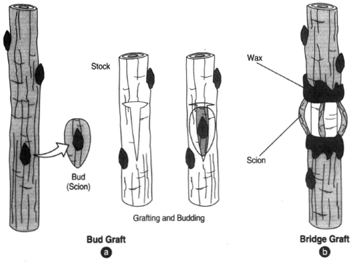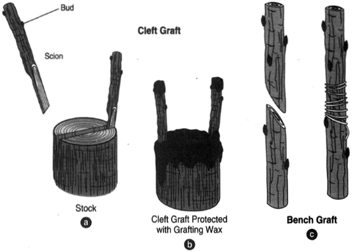Grafting
Among horticultural plants, there are numerous times when a desired shoot system does not develop well on its own root. In such situations, great improvement can be achieved by grafting the desired shoot to a root of higher quality, a root system that is more disease resistant. European varieties of grapes are regularly grafted to American-type root stock.A graft is made by fusing a scion (twig) of one variety to the base of a stem bearing the desired root system of an other variety. When the two pieces are brought together, careful attention must be given to aligning the cambiums so that the xylem and phloem of the scion and stock connect. The two parts are then bound together to allow fusion. When the healed cambium produces a continuous connection of new xylem, water conduction can occur between the parts. It is also possible to graft on higher, lateral branches, thereby producing several varieties of fruit on one tree. Sometimes, only buds are grafted to the stock (a bud graft). Various techniques employed are shown in figure 37-3.
Grafts between different species of the same genus can usually be done, as can grafts between different genera of the same family. Tissue compatibility is necessary. Lilacs can be grafted to privet; almonds can be grafted to peach stock; peaches can be grafted to cherry stock; and pecans and English walnuts can be grafted to black walnut. Potatoes and tomatoes are related and can thus be grafted:They are in the same family, Solanaceae. If a tomato scion is grafted to a tobacco rootstock, the leaves of the tomato will have nicotine, demonstrating that the nicotine in tobacco leaves is produced in the roots of the tobacco plant.
 |
| Figure 37-3 (a) Bud grafting: a bud excised from a stem is placed under bark having been opened by either a T- or a door-shaped cut.( b) A bridge graft can be used to repair an injured stem. |
 |
| Figure 37-4 Grafting of a scion on a stock. (a) A cleft graft (used in top working a tree). (b) The cleft graft protected with grafting wax. (c) A bench graft secured by a waxed string. |




